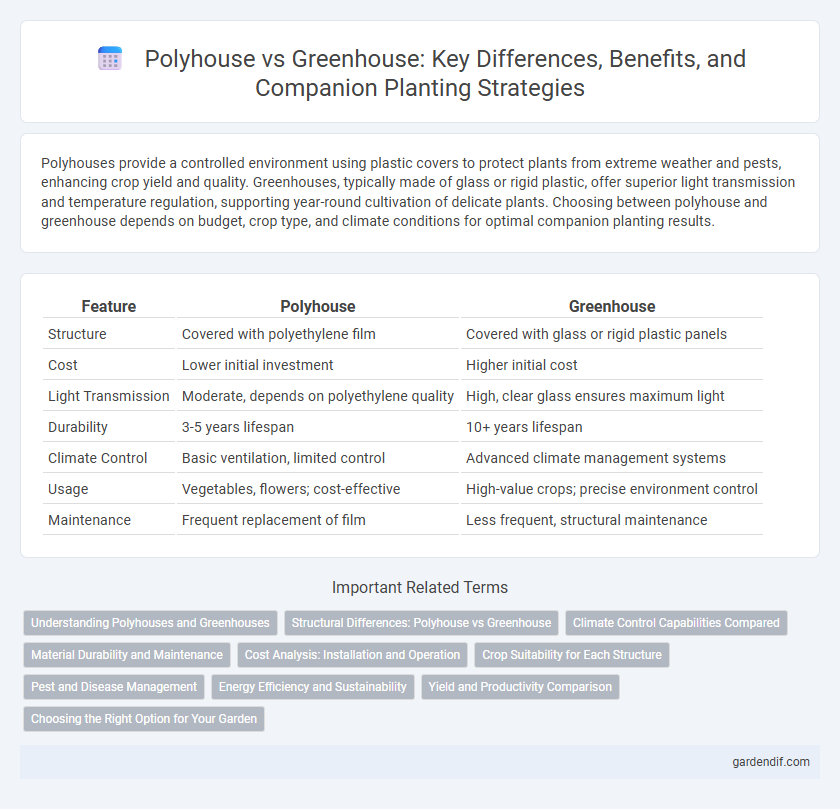
Polyhouse vs Greenhouse Illustration
Polyhouses provide a controlled environment using plastic covers to protect plants from extreme weather and pests, enhancing crop yield and quality. Greenhouses, typically made of glass or rigid plastic, offer superior light transmission and temperature regulation, supporting year-round cultivation of delicate plants. Choosing between polyhouse and greenhouse depends on budget, crop type, and climate conditions for optimal companion planting results.
Table of Comparison
| Feature | Polyhouse | Greenhouse |
|---|---|---|
| Structure | Covered with polyethylene film | Covered with glass or rigid plastic panels |
| Cost | Lower initial investment | Higher initial cost |
| Light Transmission | Moderate, depends on polyethylene quality | High, clear glass ensures maximum light |
| Durability | 3-5 years lifespan | 10+ years lifespan |
| Climate Control | Basic ventilation, limited control | Advanced climate management systems |
| Usage | Vegetables, flowers; cost-effective | High-value crops; precise environment control |
| Maintenance | Frequent replacement of film | Less frequent, structural maintenance |
Understanding Polyhouses and Greenhouses
Polyhouses and greenhouses both provide controlled environments for plant growth but differ significantly in structure and functionality. Polyhouses use polyethylene sheets supported by metal or wooden frames to create a high-humidity, insect-proof environment ideal for vegetable cultivation, while greenhouses often feature glass or plastic panels designed to maximize light penetration and temperature control for a wider variety of plants. Understanding these distinctions helps optimize crop yield and resource efficiency according to specific agricultural needs.
Structural Differences: Polyhouse vs Greenhouse
Polyhouses feature a lightweight frame covered with UV-stabilized polyethylene film, allowing higher light transmission and better ventilation control compared to greenhouses, which typically use glass or rigid plastic panels within a sturdier metal or wooden frame. The structural design of polyhouses emphasizes flexibility and cost-effectiveness, while greenhouses provide greater durability and insulation due to their rigid construction. These differences impact temperature regulation, humidity control, and crop selection in controlled environment agriculture.
Climate Control Capabilities Compared
Polyhouses offer superior climate control capabilities compared to traditional greenhouses by using translucent polythene covers that optimize light diffusion and temperature regulation. These structures rely on automated ventilation systems, shading nets, and misting devices to maintain consistent humidity and temperature levels essential for high-value crop cultivation. In contrast, greenhouses typically use glass or rigid plastic panels, which provide less flexibility in controlling microclimates, often leading to higher energy consumption and less efficient environmental control.
Material Durability and Maintenance
Polyhouses constructed with polyethylene films offer moderate durability but require regular replacement due to UV degradation, impacting long-term maintenance costs. Greenhouses built from glass or polycarbonate panels provide superior material durability, ensuring extended lifespan with minimal upkeep. The sturdy frameworks of greenhouses reduce maintenance frequency, making them a cost-effective solution for sustained plant protection.
Cost Analysis: Installation and Operation
Polyhouses typically require lower installation costs due to simpler materials like polyethylene films, while greenhouses often involve more expensive glass or rigid panels. Operational expenses for polyhouses are generally reduced because of lower energy demands and maintenance needs, whereas greenhouses may incur higher costs for climate control systems and structural upkeep. Cost analysis favors polyhouses for budget-conscious growers seeking efficient protection with minimal initial and ongoing investments.
Crop Suitability for Each Structure
Polyhouses provide a controlled environment ideal for cultivating delicate crops like tomatoes, capsicums, and cucumbers by regulating temperature, humidity, and light exposure, which enhances growth and yield. Greenhouses, with their more rigid structures and often glass covering, are suitable for high-value crops such as flowers, strawberries, and exotic plants that require precise climate control and protection from pests. Crop suitability depends on the specific environmental control needs, with polyhouses preferred for vegetables in tropical climates and greenhouses favored for floriculture and high-value horticultural crops.
Pest and Disease Management
Polyhouses provide enhanced pest and disease management by offering a controlled environment that reduces exposure to external pests and minimizes the spread of diseases, unlike traditional greenhouses which may have more open ventilation. The structure of polyhouses allows for better regulation of humidity, temperature, and air circulation, critical factors in preventing fungal infections and pest infestations. Implementing integrated pest management (IPM) strategies is more effective in polyhouses due to the ability to monitor and control the microclimate closely, resulting in healthier crops and reduced pesticide usage.
Energy Efficiency and Sustainability
Polyhouses use translucent polyethylene covers that allow maximum light penetration while minimizing heat loss, making them highly energy-efficient compared to traditional glass greenhouses. Their lightweight materials reduce construction costs and carbon footprint, enhancing sustainability. Greenhouses, though durable with glass or polycarbonate panels, consume more energy for temperature regulation due to lower insulation properties.
Yield and Productivity Comparison
Polyhouses offer higher yield efficiency than traditional greenhouses due to controlled temperature, humidity, and light conditions, optimizing photosynthesis and plant growth. The microclimate stability in polyhouses reduces pest incidence and water usage, resulting in increased productivity per square meter. Greenhouses, while effective, generally provide less precise environmental control, potentially limiting maximum crop yield and growth rates compared to polyhouses.
Choosing the Right Option for Your Garden
Polyhouses offer controlled environments with high humidity and temperature regulation, ideal for tropical plants and high-yield crops. Greenhouses provide more versatility with varied designs and materials, allowing for year-round cultivation of diverse plant species. Selecting the right option depends on your local climate, crop requirements, and budget constraints for effective garden growth.
Polyhouse vs Greenhouse Infographic

 gardendif.com
gardendif.com